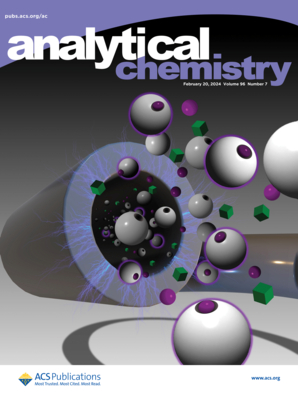Tuning Microenvironment over Metal-Organic Frameworks for Efficient Enzyme Immobilization and Sensitive Immunoassay.
IF 6.7
1区 化学
Q1 CHEMISTRY, ANALYTICAL
引用次数: 0
Abstract
Immobilizing enzymes within metal-organic frameworks (MOFs) enables enzymes to act against extreme environments. However, immobilized enzymes usually face confined and inappropriate microenvironments, resulting in decreased bioactivity and significantly affecting their practical applications. Herein, we propose a functionalized hierarchically porous MOF (HP-MOFs) for efficient enzyme immobilization. The functionalized ligands were introduced to tune the microenvironments, followed by the utilization of the acid etching strategy to further enrich the mesoporous structure. The obtained HP-MOFs with a matching pore size with enzyme (cytochrome c, Cyt c) not only show high loading amounts (19.00%) but also facilitate the accessibility of enzymes. Importantly, the -OH functionalization enhanced the hydrophilicity of the carrier for maintaining the secondary structure of Cyt c and achieving a superior catalytic activity. Furthermore, the engineered HP-MOF-OH@Cyt c exhibits excellent recyclability and tolerance to inhospitable conditions. Capitalizing on the unique interaction of the Zr-O-P bond, the resultant HP-MOF-OH@Cyt c-based biosensor is constructed for a sensitive chlorpyrifos assay. The proposed biosensor has a good linear relationship with the concentration from 10 pg mL-1 to 10 000 pg mL-1, with a low detection limit of 4.63 pg mL-1. This work represents a good advance in enzyme immobilization and is expected to show great prospects in practical enzyme-involved applications.调整金属-有机框架微环境用于高效酶固定和敏感免疫分析。
将酶固定在金属有机框架(MOFs)内,使酶能够对抗极端环境。然而,固定化酶通常面临受限和不适当的微环境,导致生物活性降低,严重影响其实际应用。在此,我们提出了一种功能化的分层多孔MOF (hp -MOF)用于高效的酶固定化。引入功能化配体调整微环境,然后利用酸蚀策略进一步丰富介孔结构。所得的hp - mof与酶(细胞色素c、细胞色素c)孔径匹配,不仅上载量高(19.00%),而且有利于酶的接近。重要的是,-OH功能化增强了载体的亲水性,从而维持了Cyt - c的二级结构,并获得了优异的催化活性。此外,工程HP-MOF-OH@Cyt c表现出优异的可回收性和对恶劣条件的耐受性。利用Zr-O-P键的独特相互作用,构建了基于HP-MOF-OH@Cyt c的生物传感器,用于灵敏的毒死蜱测定。该传感器与浓度在10 pg mL-1 ~ 10 000 pg mL-1范围内具有良好的线性关系,低检出限为4.63 pg mL-1。这一研究成果在酶固定化方面取得了良好的进展,在实际应用中具有广阔的前景。
本文章由计算机程序翻译,如有差异,请以英文原文为准。
求助全文
约1分钟内获得全文
求助全文
来源期刊

Analytical Chemistry
化学-分析化学
CiteScore
12.10
自引率
12.20%
发文量
1949
审稿时长
1.4 months
期刊介绍:
Analytical Chemistry, a peer-reviewed research journal, focuses on disseminating new and original knowledge across all branches of analytical chemistry. Fundamental articles may explore general principles of chemical measurement science and need not directly address existing or potential analytical methodology. They can be entirely theoretical or report experimental results. Contributions may cover various phases of analytical operations, including sampling, bioanalysis, electrochemistry, mass spectrometry, microscale and nanoscale systems, environmental analysis, separations, spectroscopy, chemical reactions and selectivity, instrumentation, imaging, surface analysis, and data processing. Papers discussing known analytical methods should present a significant, original application of the method, a notable improvement, or results on an important analyte.
 求助内容:
求助内容: 应助结果提醒方式:
应助结果提醒方式:


